Bishop Auckland: Difference between revisions
No edit summary |
|||
| (One intermediate revision by the same user not shown) | |||
| Line 16: | Line 16: | ||
}} | }} | ||
'''Bishop Auckland''' is a historic market town in [[County Durham]], about 12 miles northwest of [[Darlington]] and 12 miles southwest of [[Durham]] at the meeting of the [[River Wear]] with its tributary the [[River Gaunless]]. | '''Bishop Auckland''' is a historic market town in [[County Durham]], about 12 miles northwest of [[Darlington]] and 12 miles southwest of [[Durham]] at the meeting of the [[River Wear]] with its tributary the [[River Gaunless]]. | ||
The major focus of the town is [[Auckland Castle]], the palace of the Bishops of Durham, its impressive gate opening onto th market place. | |||
Much of the town's early history was shaped by the [[Diocese of Durham|Bishops of Durham]], who ruled the county as palatine lords, and here they established a hunting lodge. The lodge later became the main residence of the Bishops of Durham,<ref name="S41">{{Harvnb |Simpson|1991|p=41}}</ref><ref name="ACHist" /><ref name="Fordyce545" /> and this link gave the town the distinctive prefix to its name. | Much of the town's early history was shaped by the [[Diocese of Durham|Bishops of Durham]], who ruled the county as palatine lords, and here they established a hunting lodge. The lodge later became the main residence of the Bishops of Durham,<ref name="S41">{{Harvnb |Simpson|1991|p=41}}</ref><ref name="ACHist" /><ref name="Fordyce545" /> and this link gave the town the distinctive prefix to its name. | ||
| Line 63: | Line 65: | ||
The name "Gaunless" itself is of later, Norse, origin, meaning ''useless''.<ref name="Gelling" /><ref>{{Harvnb |Simpson|2002|p=132}}</ref> It is believed that this derives from the river's inability to power a mill, sustain fish or create fertile floodplains. | The name "Gaunless" itself is of later, Norse, origin, meaning ''useless''.<ref name="Gelling" /><ref>{{Harvnb |Simpson|2002|p=132}}</ref> It is believed that this derives from the river's inability to power a mill, sustain fish or create fertile floodplains. | ||
==About the town= | ==About the town== | ||
Bishop Auckland is on the Durham coalfield at the confluence of the [[River Wear]] with its tributary the River Gaunless.<ref name="S41" /> The town nestles in the rivers' valley about {{convert|100|m|ft|0|x}} above sea level. Besides this the town is all but is surrounded on all sides by hills ranging in height from around {{convert|150|m|ft|0|x}} above sea level to over {{convert|220|m|ft|0|x}} above sea level. | Bishop Auckland is on the Durham coalfield at the confluence of the [[River Wear]] with its tributary the River Gaunless.<ref name="S41" /> The town nestles in the rivers' valley about {{convert|100|m|ft|0|x}} above sea level. Besides this the town is all but is surrounded on all sides by hills ranging in height from around {{convert|150|m|ft|0|x}} above sea level to over {{convert|220|m|ft|0|x}} above sea level. | ||
Latest revision as of 15:13, 31 August 2024
| Bishop Auckland | |
| County Durham | |
|---|---|
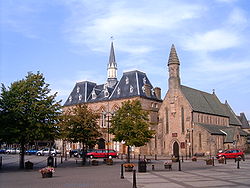 Bishop Auckland Town Hall | |
| Location | |
| Grid reference: | NZ208294 |
| Location: | 54°39’24"N, 1°40’36"W |
| Data | |
| Population: | 24,392 (2001) |
| Post town: | Bishop Auckland |
| Postcode: | DL14 |
| Dialling code: | 01388 |
| Local Government | |
| Council: | County Durham |
| Parliamentary constituency: |
Bishop Auckland |
Bishop Auckland is a historic market town in County Durham, about 12 miles northwest of Darlington and 12 miles southwest of Durham at the meeting of the River Wear with its tributary the River Gaunless.
The major focus of the town is Auckland Castle, the palace of the Bishops of Durham, its impressive gate opening onto th market place.
Much of the town's early history was shaped by the Bishops of Durham, who ruled the county as palatine lords, and here they established a hunting lodge. The lodge later became the main residence of the Bishops of Durham,[1][2][3] and this link gave the town the distinctive prefix to its name.
During the Industrial Revolution, the town grew rapidly as coal mining took hold as an important industry. The subsequent decline of the coal mining industry in the late twentieth century has been blamed for a fall in the town's fortunes in other sectors.[4] Today, the largest sector of employment in the town is manufacturing.
Name
The first part of the name, "Bishop", refers to the land being owned by and the town being the residence of the Bishop of Durham.[5][6][7]
The derivation of "Auckland" is less clear. One suggestion is that "Auckland" is the Norse Aukland meaning "additional land" ('eke land').[6][7] This could refer to the area being extra land granted to the Bishop of Durham by King Canute in around 1020.[8]
Another suggestion is that it is the Old English Acland, meaning "oakland".[5]
A wilder proposal is that "Aukland" derives from Alclit meaning "Rock on the Clyde"; Dumbarton used to bear the name as Alcluith or Alclut,[7] ", though this would require that the Gaunless had once been named "Clyde".
"Auckland" is also used in the settlements of St Helen Auckland and West Auckland, all of which are along the path of the Gaunless.
The name "Gaunless" itself is of later, Norse, origin, meaning useless.[6][9] It is believed that this derives from the river's inability to power a mill, sustain fish or create fertile floodplains.
About the town
Bishop Auckland is on the Durham coalfield at the confluence of the River Wear with its tributary the River Gaunless.[1] The town nestles in the rivers' valley about 328 feet above sea level. Besides this the town is all but is surrounded on all sides by hills ranging in height from around 492 feet above sea level to over 722 feet above sea level.
Earliest history
Mesolithic,[10][11] Neolithic[12] and Bronze Age,[13] artefacts have been unearthed. There is evidence of possible Iron Age settlements around the town,[14][15] and the Romans had a look-out post where Auckland Castle is sited today and a 10 acre fort at nearby Binchester.
The earliest known reference to Bishop Auckland itself is around 1000AD as land given to the Earl of Northumberland for defending the church against the Scots.[16] It is also mentioned in 1020 as a gift given to the Bishop of Durham by King Canute. However, a village almost certainly existed on the town's present site long before this, with there being evidence of church on the site of St Andrew's Church in South Church as early as the seventh century.[17] Furthermore,
The Bishops of Durham
In 1083, Bishop William de St-Calais expelled a number of canons from Durham. Some of these settled in the area and established a collegiate church.[17] Around 1183 Bishop Pudsey established a manor house in the town, with a great hall being completed in 1195 on the site occupied by St Peter's Chapel today.[1][16] Bishop Bek, who preferred the town as his main residence over Durham Castle due to its proximity to hunting grounds, later converted the manor house into a castle. The grounds of the castle were noted as being large enough to contain 16000 men ahead of the Battle of Neville's Cross in 1346.[16]
Between 1283 and 1310, Bek was also responsible for ordering the replacement of the collegiate church established in 1183 with the Church of St Andrew that stands in South Church today,[17] together with accommodation for the canons; the building known today as the East Deanery.[18]
The collegiate church also appears to have supported a school. The collegiate church was re-organised under Bishop Thomas Langley in 1428 and at some point in the same century moved to the castle grounds. The college and its school were finally dissolved in the 15th century.[19] [20][21]
The school was revived in the reign of King James I when in 1604 Anne Swifte petitioned the King to found a school and the Free Grammar School of King James, the direct descendant of today's King James I school, was established. Although, the school's early location is unknown, in 1638 Bishop Morton granted the school space in an old chapel in the Market Place.[21][22]
Also in 1604, James's son, the future King Charles I made the first of three visits he would make to the town during his life. On this visit, his first to England, he was entertained by Bishop Tobias Matthew. James himself stayed in Auckland Castle between 17 and 19 April 1617.[23] Later, on 8 May, at Durham Castle King James is reputed to have rebuked Bishop William James so badly that the Bishop returned to Auckland Castle and died three days later.[24]
Charles's second visit to the town was on his way to Scotland on 31 May 1633, when he was entertained by Bishop Morton. His third visit on 4 February 1647 was in less lavish circumstances, as a prisoner. Morton had fled the town in 1640 and the castle was empty.[23][24] Consequently, the king had to stay in a public house off the Market Place owned by Christopher Dobson.[25]
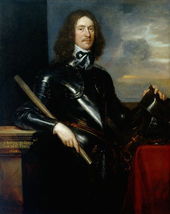
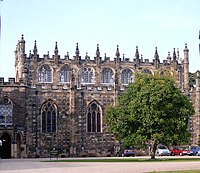
After the abolition of the bishops at the end of the Civil War, Auckland Castle was sold by Parliament to Sir Arthur Hazelrig, who demolished much of the castle, including the chapel, and built a mansion.[26][27][28] After the restoration of the monarchy in 1660, the new Bishop of Durham, John Cosin, in turn demolished Hazelrig's mansion and rebuilt the castle converting the banqueting hall into the chapel that stands today.[26][29]
Industrial Revolution
By 1801, the town had a population of 1861.[3] At the end of the eighteenth century the town had no notable roads other than the Roman road and little trade beyond weaving.[30][31] Although, coal mining existed on a small-scale had existed as early as 1183 when it is mentioned in the Boldon Book,[32] it was limited by the lack of an easy way to transport coal away from the area.[33] All this changed with the arrival railways in the early nineteenth century, which allowed large scale coal mining.[34] The railways allowed coal to be mined, and then transported to the coast before being put onto ships to London and even abroad.[35]
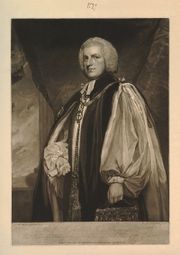
The Bishop, Shute Barrington was a keen proponent of the use of education to improve the social and moral circumstances of the lower social classes. He used £70,000 received from lead mining royalties in Weardale to fund the establishment of a number of schools in the area. One of these schools was the Bishop Barrington School, one of the town's three comprehensive schools today.[36] The Bishop Barrington School opened on 26 May 1810, the Bishop's own birthday. The school even allowed girls to attend until the age of 11 years.[37] Barrington's support of education for the poor was not without controversy. Some suggested education of the poor would lead people to question their position in society, others even blamed it for the French Revolution.[38][39]
Barrington's successor, William van Mildert was involved in the creation of Durham University. Durham Castle was donated to the new university and Auckland Castle, usually the preferred residence by successive Bishops, became the Bishop of Durham's official residence in 1832.[2] However, the influence of the Prince Bishops of Durham was on the wane and there was pressure for reform. Van Mildert would be the last Prince Bishop. Shortly after his death, in 1836, the position was stripped of its ancient powers and the palatinate jurisdiction vested in the Crown.[40][41]
By 1851 the population of the town had more than doubled to 5112.[3] A great proportion of the population working in ironworks and collieries.[30] By 1891, the population had doubled again.[42] In the second half of the nineteenth century there were typically around 60 collieries in the area open at any one time.[43] By the turn of the twentieth century 16,000 people were employed in the mining industry in the area.[44]
The town also became an important centre for rail, with large amounts of minerals such as coal, limestone and ironstone mined in the surrounding area passing through the town on the way to the coast.[45] In the neighbouring town of Shildon large numbers were employed in the railways, were a railway engine works were established.[46]
Industrial decline
By the early years of the twentieth century coal mining started to go into decline as coal reserves started to become exhausted. By the end of the 1920s unemployment had hit 27% and the population too had started to decline, as colliery employment had halved compared with ten years previously.[47][48] With the onset of the Great Depression unemployment rose to 60% in 1932 before easing back to 36% in 1937.[48] The Second World War offered a temporary reprieve for the coal industry, however, after the war the decline continued.[49] The last deep colliery in the area closed in 1968, although the much more mechanised, and less labour-intensive, surface level opencast mining did continue.[50]
Equally, the railways that had also supported the area were also scaled back,[19] ultimately culminating in the closure of Shildon's Wagon works in 1984 which resulted in the loss of thousands of jobs.[51]
Economy
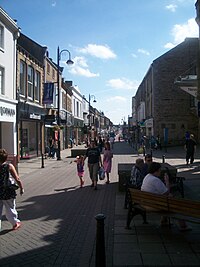
At the end of the eighteenth century the town is noted as having little trade beyond weaving.[30][31] The first mention of coal mining in the area is in the Boldon Book of 1183.[32] However, early coal mining was limited by the lack of an easy way to transport coal away from the area.[33] The arrival of the railways transformed the town as it allowed coal to be mined, and then transported to the coast before being put onto ships to London and even abroad.[35] At the start of the twentieth century 16,000 people were employed in the mining industry in the area.[44] However, by 1915 the coal industry in the town had started to decline as coal reserves started to become exhausted.[47] The last deep colliery in the area closed in 1968.[50]
Today, with the decline of the Durham coalfield, manufacturing has been left as the largest sector of employment in the town, accounting for 24.6% of the town's employment.
The town also traditionally had a strong retail sector,[4] as one of the county's main population centre's shoppers were attracted from smaller settlements on the Durham coalfield for miles around. However, the effect of the decline in the coal mining industry has been felt in the retail sector. Together with competition from local shopping malls such as the MetroCentre in Gateshead, the decline in the mining industry has been blamed for a downturn in the fortunes of retailers,[52] with commentators lamenting the number of down market stores and charity shops in the town centre.[53] In response, numerous initiatives to regenerate the town centre have been proposed including the launch of the Bishop Auckland Town Centre Forum,[54] and the 2006 regeneration master plan drawn up by Red Box Group, which was sponsored by Wear Valley District Council and the regional development agency One NorthEast.[55]
Sights of the town
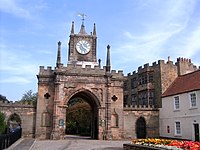
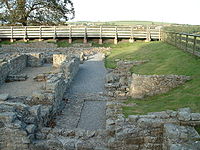
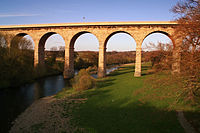
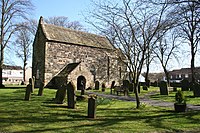
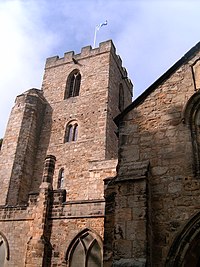
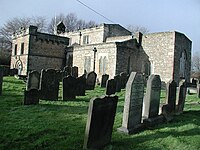
The town has a number of Grade I listed buildings. The grounds of Auckland Castle alone contain seven such structures. Additionally in nearby Escomb is a beautifully preserved, almost wholly original Anglo-Saxon Church.
In Auckland are:
- St Andrew's parish church,[56]
- St Helen's church,[57]
- St Helen Hall,[58]
- West Auckland Manor House,[59]
- The East Deanery[60]
- Bishop Skirlaw Bridge (14th century)[61]
Other notable buildings include the town hall, a Victorian railway viaduct and Binchester Roman fort.
Auckland Castle
- Main article: Auckland Castle
Auckland Castle (often known locally as The Bishop's palace), has been the official residence of the Bishop of Durham since 1832. However, its history goes back much earlier, being established as a hunting lodge for the Prince Bishops of Durham.[2]
The castle is surrounded by 800 acres of parkland, which was originally used by the Bishops for hunting and is today open to the public.[62] The castle and its grounds contain seven Grade I listed structures.[63]
- West Mural Wall[64]
- Gatehouse[65]
- Chapel of St Peter[66]
- Screen Wall[67]
- Deer Shelter[68]
- Lodge [69]
The castle's long dining has twelve of the thirteen portraits of Jacob and his 12 sons painted by Francisco de Zurbarán in the 17th century, which were saved by Bishop Richard Trevor in 1756.[70] Trevor was unable to secure the 13th, Benjamin, so he commissioned Arthur Pond to produce a copy, which hangs alongside the 12 other originals.[71]
Auckland Castle also provides the setting for Lewis Carroll's story A Legend of Scotland.
Binchester Roman Fort
- Main article: Binchester Roman Fort
The route of the Roman road Dere Street passes straight through the middle of the town on its way to the nearby Roman Fort at Binchester. Binchester Roman]] Fort, or Vinovia as it was known to the Romans, has one of the best preserved examples of a Roman military bath house hypocaust in the country.[72] Bishop Auckland's main shopping street, Newgate Street, together with Cockton Hill Road and Watling Road faithfully follow the route of Dere Street.[73]
Town Hall
The Town Hall is a "Gothic style" Victorian building overlooking the town's market place and is Grade II* listed.[74] After being abandoned and then condemned for demolition in the 1980s, the town hall was fully restored in the early 1990s. It now houses the town's main public library, a theatre, an art gallery, tourist information centre and a café-bar.[75]
Newton Cap viaduct
The town also has a Grade II listed Victorian railway viaduct crossing the River Wear.[76] At 105 feet high, the viaduct provides views of the surrounding countryside below as well as Auckland Castle, the Bishop's Park and the Town Hall on approaching the town from the Viaduct. It was originally built in 1857[76] to carry the Bishop Auckland to Durham City railway line across the River Wear and the Newton Cap Bank that leads down to the river. The railway closed in 1968 and the viaduct fell into a period of disuse and was at one point threatened with demolition.[77] However, in 1995, the viaduct was converted for vehicle use to take traffic on the A689 between Bishop Auckland and Crook, relieving the Grade I listed[61] fourteenth century single lane Bishop Skirlaw bridge which sits in the valley below it.[75][78]
St Andrew's Church
St Andrew's church located in the adjoining village of South Church is the largest church in County Durham[79][80] and a Grade I listed building. The church was built in the thirteenth century and acted as a collegiate church.[56][81]
Churches
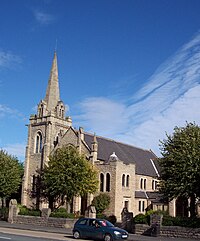
The town is in the located within the Auckland Deanery of the Diocese of Durham.
Bishop Auckland has 3 Grade I listed churches; the Church of St Helen,[57] the Church of St Andrew,[56] and St Peter's chapel at Auckland Castle.[63] Another Grade I listed church, the Saxon church at Escomb is also close to the town.
Additionally, the town has 3 grade II listed churches; Bishop Auckland Methodist Church on Cockton Hill Road,[82] St Anne's church next to the town hall in the Market Place,[83] and St Peter's Church on Princes Street.[84]
Churches in the town include:
- Church of England:
- St Andrew
- St Anne
- St Helen
- St Peter
- Baptist: Bishop Auckland Baptist Church
- Methodist: Bishop Auckland Methodist Church
Sports
Football
Bishop Auckland AFC is an amateur club which has won the FA Amateur Cup 10 times in the Trophy's 80-year history and played in the Final on 18 occasions.[85]
Bishop Auckland Football Club helped out Manchester United after the Munich Air Crash in 1958 by donating three of their players, Derek Lewin, Bob Hardisty and Warren Bradley (footballer)|Warren Bradley. In return in 1996, Manchester United played a friendly against Bishop Auckland to help raise money when the club was threatened with bankruptcy after a member of a rival team sued over an injury. In 2007 Manchester United donated floodlights to Bishop Auckland Football Club, which the club has added to their new ground.[86][87]
West Auckland Town FC was the team to win one of the first international footballing competitions, the Sir Thomas Lipton Trophy, sometimes referred to as The First World Cup. Its team of local coal miners won the cup in the Easter of 1909 and again in 1911, defeating the mighty Juventus in the final.[88] This story was portrayed in the 1982 television film "The World Cup - A Captain's Tale" made by Tyne Tees Television and starring Dennis Waterman.[89] The cup itself was stolen from West Auckland Town FC in 1994 and a replica now resides in West Auckland working men's club.[88]
Facilities
Woodhouse Close Leisure Complex is a municipal leisure centre with a swimming pool and "learner" pool, gym, sauna, steam room and spa pool.
The Town Recreation Ground and Cockton Hill Recreation Ground have football pitches, tennis courts and bowling greens.
Henknowle Recreation Ground has a 5 a side pitch and a basketball court.
Outside links
| ("Wikimedia Commons" has material about Bishop Auckland) |
References
- ↑ 1.0 1.1 1.2 Simpson 1991, p. 41
- ↑ 2.0 2.1 2.2 Castle History - Auckland Castle
- ↑ 3.0 3.1 3.2 Fordyce 1857, p. 545
- ↑ 4.0 4.1 £2.4 m 'people's plan' to revive economy of market town, The Northern Echo, 9 August 2000, http://archive.thenorthernecho.co.uk/2000/8/9/194536.html, retrieved 26 August 2008
- ↑ 5.0 5.1 Simpson, David, The North East England History Pages — Place Names, http://www.northeastengland.talktalk.net/Place%20Name%20Meanings%20A%20to%20D.htm, retrieved 26 August 2008
- ↑ 6.0 6.1 6.2 Gelling, Margaret; W. F. H. Nicolaisen, Melville Richards (1970), The names of towns and cities in Britain, Batsford, p. 53
- ↑ 7.0 7.1 7.2 Ekwall, Eilert (1960), The concise Oxford dictionary of place names (4 ed.), Oxford University Press, pp. 18–19
- ↑ Echo Memories: Tides of change in the land of Canute, The Northern Echo, 20 July 2005, archived from the original on 27 September 2007, http://web.archive.org/web/20070927173424/http://www.northeasthistory.co.uk/the_north_east/history/echomemories/darlington/305/200705.html, retrieved 26 August 2008
- ↑ Simpson 2002, p. 132
- ↑ National Monuments Record: No. 24317
- ↑ National Monuments Record: No. 23956
- ↑ National Monuments Record: No. 22197
- ↑ National Monuments Record: No. 24309
- ↑ National Monuments Record: No. 24313
- ↑ National Monuments Record: No. 24335
- ↑ 16.0 16.1 16.2 Hutchinson 2005, p. 14
- ↑ 17.0 17.1 17.2 Hutchinson 2009, p. 4
- ↑ Hutchinson 2009, p. 9
- ↑ 19.0 19.1 Laurie, Barbara, A Short History of Bishop Auckland, Bishop Auckland Town, archived from the original on 13 December 2009, http://www.webcitation.org/5lzb7gUsr, retrieved 26 August 2008
- ↑ Fordyce 1857, p. 543
- ↑ 21.0 21.1 Page, William (1905), A history of the County of Durham, Victoria History of the Counties of England, 1, Constable, pp. 397–398
- ↑ Hutchinson 2005, p. 75
- ↑ 23.0 23.1 Hutchinson 2005, p. 15
- ↑ 24.0 24.1 Fordyce 1857, p. 547
- ↑ (PDF) Castle State Rooms, Auckland Castle, http://www.auckland-castle.co.uk/downloads/aucklandcastlehistory.pdf, retrieved 16 September 2009
- ↑ 26.0 26.1 Lightfoot, Joseph Barber (1892), Leaders in the Northern Church: Sermons Preached in the Diocese of Durham, Macmillan, p. 140
- ↑ Dodds, Glen Lyndon (1996), Historic Sites of County Durham, Sunderland: Albion,, p. 16, ISBN 978-0-9525122-5-7
- ↑ Whellan 1856, p. 279
- ↑ Fordyce 1857, p. 548
- ↑ 30.0 30.1 30.2 Fordyce 1857, p. 558
- ↑ 31.0 31.1 Fordyce 1857, p. 552
- ↑ 32.0 32.1 Simpson 1991, p. 25
- ↑ 33.0 33.1 Hutchinson 2005, p. 33
- ↑ Whellan 1856, p. 276
- ↑ 35.0 35.1 Whellan 1856, p. 292
- ↑ Hunt, Christopher John (1970), The lead miners of the Northern Pennines: in the eighteenth and nineteenth centuries, Manchester: Manchester University Press, p. 236, ISBN 978-0-7190-0380-6
- ↑ Hutchinson 2005, pp. 76–77
- ↑ Varley, E. A. (2004), "Barrington, Shute (1734–1826)", Oxford Dictionary of National Biography, Oxford University Press, http://www.oxforddnb.com/view/article/1534, retrieved 29 September 2009
- ↑ Soloway, R. A. (1969), Prelates and people: ecclesiastical social thought in England, 1783–1852, London: Taylor & Francis, p. 356, ISBN 978-0-7100-6331-1
- ↑ Varley, E. A. (2004), "Mildert, William Van (1765–1836)", Oxford Dictionary of National Biography, Oxford University Press, http://www.oxforddnb.com/view/article/28096, retrieved 29 September 2009
- ↑ Brickstock, Richard (2007), Durham Castle: Fortress, Palace, College, Lindley: Jeremy Mills Publishing, pp. 52–53, ISBN 978-1-905217-24-3
- ↑ Hutchinson 2005, p. 56
- ↑ Hutchinson 2005, p. 48
- ↑ 44.0 44.1 Hutchinson 2005, p. 43
- ↑ Hutchinson 2005, p. 44
- ↑ Fordyce 1857, pp. 567–569
- ↑ 47.0 47.1 Hutchinson 2005, pp. 82–84
- ↑ 48.0 48.1 Bulmer, Martin (1978), Mining and Social Change: Durham County in the Twentieth Century, London: Taylor & Francis, p. 145, ISBN 978-0-85664-509-9, http://books.google.com/?id=kwIOAAAAQAAJ, retrieved 6 June 2009
- ↑ Thematic Overview — Industrial, Durham County Council, http://www.keystothepast.info/k2p/usp.nsf/pws/Keys+to+the+Past+-+Overviews+-+Industrial, retrieved 29 August 2008
- ↑ 50.0 50.1 Hutchinson 2005, p. 104
- ↑ Railway works resurrected decades after closure blow, The Northern Echo, 10 August 2006, http://archive.thenorthernecho.co.uk/2006/8/10/226520.html, retrieved 26 August 2008
- ↑ Action plan aims to revive town fortunes, The Northern Echo, 26 October 2000, http://archive.thenorthernecho.co.uk/2000/10/26/188625.html, retrieved 26 August 2008
- ↑ End of an era as charity shop pioneer pulls out, The Northern Echo, 13 June 2000, http://archive.thenorthernecho.co.uk/2000/8/9/194536.html, retrieved 26 August 2008
- ↑ Bishop Auckland Town Centre Forum, Enterprising Britain, http://www.makeyourmark.org.uk/inspiring_stories/bishop_auckland_town_centre_forum_puts_bishop_auckland_on_the_map, retrieved 26 September 2008
- ↑ (PDF) Bishop Auckland Urban Renaissance Master Plan, Wear Valley District Council, June 2006, http://www.wearvalley.gov.uk/media/pdf/1/7/BA_Master_Plan_1.pdf, retrieved 26 September 2008
- ↑ 56.0 56.1 56.2 Church of St Andrew&nbps;- Heritage Gateway
- ↑ 57.0 57.1 Church of St Helen&nbps;- Heritage Gateway
- ↑ St Helen Hall&nbps;- Heritage Gateway
- ↑ The Manor House, West Auckland&nbps;- Heritage Gateway
- ↑ East Deanery&nbps;- Heritage Gateway
- ↑ 61.0 61.1 Newton Cap Bridge&nbps;- Heritage Gateway
- ↑ Hutchinson 2005, p. 20
- ↑ 63.0 63.1 Auckland Castle&nbps;- Heritage Gateway
- ↑ Auckland Castle West Mural Wall&nbps;- Heritage Gateway
- ↑ Auckland Castle Gatehouse&nbps;- Heritage Gateway
- ↑ {{heritagegateway|385601|Auckland Castle Chapel of St Peter
- ↑ Auckland Castle Screen Wall&nbps;- Heritage Gateway
- ↑ Auckland Castle Deer Shelter&nbps;- Heritage Gateway
- ↑ Auckland Castle Lodge&nbps;- Heritage Gateway
- ↑ Jenkins, Simon (7 October 2005), London should keep its hands off the treasures of the north, The Guardian, http://www.guardian.co.uk/artanddesign/2005/oct/07/art.politicsandthearts, retrieved 26 August 2008
- ↑ Bid to keep castle paintings in N-E, The Northern Echo, 14 May 2001, http://archive.thenorthernecho.co.uk/2001/5/14/171061.html, retrieved 26 August 2008
- ↑ Simpson 1991, pp. 44–45
- ↑ Hutchinson 2005, p. 11
- ↑ Bishop Auckland Town Hall&nbps;- Heritage Gateway
- ↑ 75.0 75.1 Hutchinson 2005, pp. 121–122
- ↑ 76.0 76.1 Newton Cap Railway Viaduct&nbps;- Heritage Gateway
- ↑ Bridge leads to a rich vein of history, The Northern Echo, 19 February 2002, http://archive.thenorthernecho.co.uk/2002/2/19/145400.html, retrieved 8 August 2008
- ↑ Hutchinson 2005, p. 128
- ↑ Hutchinson 2005, p. 70
- ↑ Pevsner, Nikolaus; Elizabeth Williamson (1985), County Durham, The Buildings of England (2 ed.), Penguin, p. 411, ISBN 978-0-14-071009-0
- ↑ Hutchinson 2009, p. 4
- ↑ Bishop Auckland Methodist Church&nbps;- Heritage Gateway
- ↑ Church of St Anne&nbps;- Heritage Gateway
- ↑ Church of St Peter&nbps;- Heritage Gateway
- ↑ Hutchinson 2005, p. 110
- ↑ Champs light the way for minnows, BBC News, 17 July 2007, archived from the original on 13 December 2009, http://www.webcitation.org/5lzbJBXkL, retrieved 24 August 2008
- ↑ Amateurs help save the day after disaster, The Journal, 6 February 2008, archived from the original on 13 December 2009, http://www.webcitation.org/5lzbOTqis, retrieved 24 August 2008
- ↑ 88.0 88.1 World Cup winners prepare to tackle new kids on block, London: The Independent, 4 October 2006, archived from the original on 13 December 2009, http://www.webcitation.org/5lzbUjzic, retrieved 9 August 2007
- ↑ "The World Cup — A Captain's Tale", Film & TV Database, British Film Institute, archived from the original on 22 November 2009, http://www.webcitation.org/5lU1qnqz7, retrieved 22 November 2009
Books
- Fordyce, William (1857), The History and Antiquities of the County Palatine of Durham, A. Fullarton and Co., http://books.google.com/?id=kDdNAAAAMAAJ&printsec=frontcover, retrieved 6 June 2009
- Hutchinson, Tom (2009), South Church Memories of an ancient Auckland community, Newcastle-upon-Tyne: Summerhill Books, ISBN 978-1-906721-15-2
- Hutchinson, Tom (2005), The History of Bishop Auckland, Seaham: The People's History, ISBN 978-1-902527-59-8
- Simpson, David A (1991), Prince Bishop country the people history and folklore of County Durham and the River Wear, North Pennine Publishing, ISBN 978-1-874617-00-6
- Simpson, David A (2002), Northern Roots, Sunderland: Business Education Publishers, ISBN 978-1-901888-35-5
- Whellan, William (1856), History, Topography, and Directory of the County Palatine of Durham, William Whellan and Co., http://books.google.com/?id=vN4MAAAAYAAJ&printsec=frontcover, retrieved 6 June 2009
